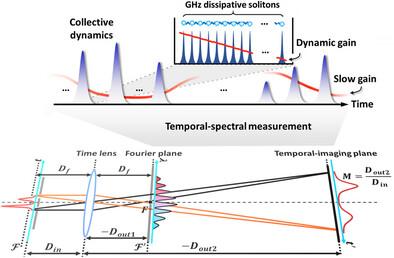GHz耗散孤子的集体动力学
IF 10
1区 物理与天体物理
Q1 OPTICS
引用次数: 0
摘要
孤子分子复合物-孤子的集体模式-在耗散光学系统中具有丰富的非线性动力学特征,使它们从跨学科的角度来看是一个重要的概念。最近,一种被称为准单孤子的新型集体图案被确定为孤子晶体的一个组成部分,对GHz孤子激光器的低阈值锁模有重要贡献。由于多尺度增益所支撑的复杂相互作用,GHz孤子激光器为研究耗散孤子的集体动力学提供了一个极好的平台,这是一个很大程度上尚未探索的领域。为此,建立了一个基于双增益效应的理论框架来预测孤子衰变和重启(SDR)的集体动力学和不规则调q不稳定性。在实验验证中,开发了一种利用单参数时间透镜的门控时间光谱测量系统。实时测量结果与GHz光纤激光器的数值预测结果吻合较好。此外,在准稳态中间阶段表现为SDR过程的间歇性动力学揭示了其与多尺度增益景观的潜在联系。这些努力可以为GHz耗散孤子的动态增益驱动的集体动力学提供新的线索。本文章由计算机程序翻译,如有差异,请以英文原文为准。

Collective Dynamics of GHz Dissipative Solitons
Soliton molecular complexes – a collective pattern of solitons – feature fruitful nonlinear dynamics in dissipative optical systems, making them a significant concept from an interdisciplinary standpoint. Recently, a new type of collective pattern termed quasi-single soliton has been identified as a constituent of the soliton crystal, significantly contributing to the low-threshold mode-locking of GHz soliton lasers. Owing to its underlying complex interactions underpinned by multi-scale gain, the GHz soliton laser serves as an excellent platform for investigating the collective dynamics of dissipative solitons, a field that remains largely unexplored. To this end, a theoretical framework based on twofold gain effects is developed to predict the collective dynamics of soliton decay and reboot (SDR) and irregular Q-switched instability. In the experimental validations, a gated temporal-spectral measurement system utilizing a single parametric time-lens is developed. The measurements in real time conform well with the numerical predictions of the GHz fiber laser. Additionally, the intermittent dynamics, manifested as the SDR process during the quasi-steady state's intermediate phase, uncovers its underlying connection with the multi-scale gain landscapes. These efforts can shed new light on the dynamic-gain-driven collective dynamics of GHz dissipative solitons.
求助全文
通过发布文献求助,成功后即可免费获取论文全文。
去求助
来源期刊
CiteScore
14.20
自引率
5.50%
发文量
314
审稿时长
2 months
期刊介绍:
Laser & Photonics Reviews is a reputable journal that publishes high-quality Reviews, original Research Articles, and Perspectives in the field of photonics and optics. It covers both theoretical and experimental aspects, including recent groundbreaking research, specific advancements, and innovative applications.
As evidence of its impact and recognition, Laser & Photonics Reviews boasts a remarkable 2022 Impact Factor of 11.0, according to the Journal Citation Reports from Clarivate Analytics (2023). Moreover, it holds impressive rankings in the InCites Journal Citation Reports: in 2021, it was ranked 6th out of 101 in the field of Optics, 15th out of 161 in Applied Physics, and 12th out of 69 in Condensed Matter Physics.
The journal uses the ISSN numbers 1863-8880 for print and 1863-8899 for online publications.

 求助内容:
求助内容: 应助结果提醒方式:
应助结果提醒方式:


